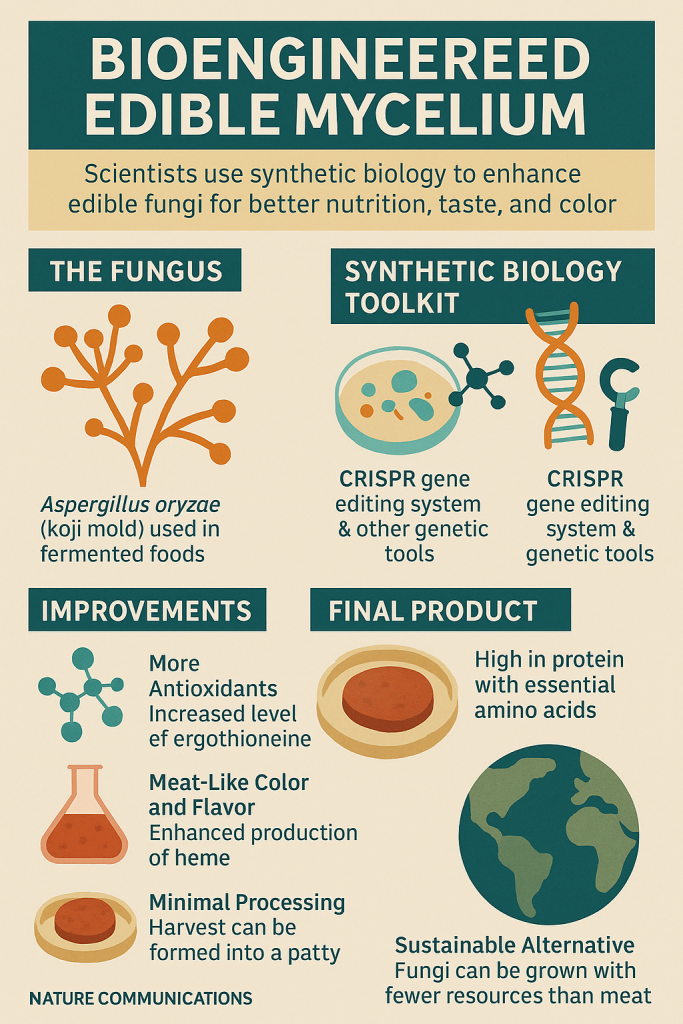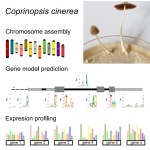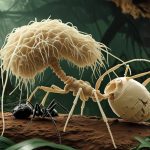In a world increasingly hungry for sustainable protein, scientists have just taken a giant step forward—by genetically reprogramming edible fungi to become not just healthier, but tastier too.
A research team from the University of California, Berkeley and its global partners has unveiled a revolutionary synthetic biology toolkit to create bioengineered edible mycelium—fungal biomass enhanced with superior nutrition, flavor, and color—without synthetic additives or animal ingredients.
Their creation? A crimson, heme-rich fungal patty that not only mimics red meat in appearance and taste, but also packs more antioxidants than a mushroom and delivers essential amino acids.

The Star: Aspergillus oryzae – A Mold You Can Eat
Often used to ferment soy sauce and miso, Aspergillus oryzae (aka koji mold) is a safe, food-grade fungus with centuries of culinary history. But this time, researchers did something new: they used CRISPR-Cas9 and a plug-and-play genetic toolkit to transform this age-old mold into a next-generation food ingredient.
What Makes It Special?
- Nutritional Power-Up:
The team boosted production of ergothioneine, a powerful antioxidant linked to heart and brain health. The engineered fungus contains more ergothioneine than mushrooms, which are currently the richest natural source. - Red Meat Look and Flavor – Naturally:
By enhancing the fungus’s own heme biosynthesis pathway, researchers achieved intracellular heme levels at 40% of those found in plant-based meat giants like Impossible™ Foods—giving the mycelium a natural reddish color and beefy flavor. - No Extensive Processing Needed:
Unlike soy or pea-based meat, which requires isolating proteins and adding color/flavor agents, this bioengineered mycelium can be directly formed into a patty with minimal processing. Just harvest, compress, and cook.
The Toolkit: CRISPR Meets Fermentation
This wasn’t just a one-off hack. The team built a full synthetic biology platform for edible fungi, including:
- A recyclable CRISPR-Cas9 editing system
- Libraries of tunable promoters and neutral genomic loci
- A powerful synthetic expression system (SES) for high protein production
- Novel bidirectional promoters for compact metabolic engineering
This toolkit allows for precise, repeatable genetic modifications—meaning the platform could be adapted to optimize fungi for flavor, color, nutrition, or even bioactive compounds in the future.
From Lab to Grill?
The engineered mycelium isn’t just healthy—it’s convincingly meat-like. Its fibrous texture mimics animal muscle, and its red hue persists even after cooking. In tests, the modified strain required no additives to become a ready-to-cook burger patty.
According to the researchers, the final product contains:
- 46% protein (dry weight)
- All essential amino acids
- No animal inputs or allergens
Why It Matters
Animal agriculture is responsible for nearly one-third of global greenhouse gas emissions. Transitioning to microbial protein like mycoprotein could cut deforestation in half and slash methane output.
Unlike traditional meat, bioengineered edible mycelium:
- Requires fewer resources
- Produces less waste
- Can be grown on food byproducts or agricultural waste
In short, it’s food for the future—grown with science, not slaughter.
What’s Next?
While consumer acceptance and regulatory hurdles remain, the study proves that fermented food can be reimagined for a more sustainable, flavorful future. The open-source toolkit is already being shared with other research labs and startups.
“This isn’t just about making better fungus,” said lead author Dr. Vayu Rekdal. “It’s about engineering fungi for the planet, for health, and for taste—all at once.”
Reference
Maini Rekdal, V., van der Luijt, C. R., Chen, Y., Kakumanu, R., Baidoo, E. E., Petzold, C. J., … & Keasling, J. D. (2024). Edible mycelium bioengineered for enhanced nutritional value and sensory appeal using a modular synthetic biology toolkit. Nature Communications, 15(1), 2099. https://doi.org/10.1038/s41467-024-46314-8





